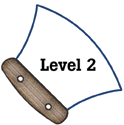 |
Mini-Unit:
Water Dance
Performance Standard
A2, Level 2
Students observe physical and chemical properties of common substances
and observe changes to those properties.
|
 |

Key Concepts and
Skills
|
- Water exists in three states—solid, liquid, gas.
- Water evaporates when heated.
- Water expands when it freezes which causes problems in Alaska.
- Liquid water expands as it is heated above 4 degrees Celsius.
- Water, snow and ice have many names in Iñupiaq.
- Ice is less dense than water.
- Measuring volume, temperature, density, mass.
|
 |

Timeline
|
2–3 weeks
|
 |

Abstract
|
Students explore states of water and changes between these states
in their community. Students investigate changes as water freezes,
liquefies, evaporates, and boils. Students learn many Iñupiaq
names for water, ice, and snow and the significance of each name
|
 |

Materials
|
- Clipboards for note taking
- freezer to make ice cubes
- Go Home River by Jim Magdanz
- rulers
- List of Iñupiaq names for water (see below)
- graduated cylinders
- water
- hot plates
- plastic bottles to hold water
- balance with gram masses
- pans for boiling water
|
 |

Activities
|
1
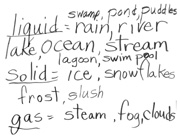 Read
the book Go Home River by Jim Magdanz; ask the students what they
know about the states of water, how and where it exists around
the community. List. Read
the book Go Home River by Jim Magdanz; ask the students what they
know about the states of water, how and where it exists around
the community. List.
Embedded Assessment
Check list for previous understanding of concepts.
2
Take students for a “water walk” around the community;
list a variety of usual and unusual forms in which water exists
in their environment and changes in the states of water that are
observed at different seasons; record in journal; share with the
class.
3
 Students
conduct an interview of Elders or adults in the community or their
family. Before they go, you may want to review the relevant forms
of water in all three states, such as snow, sleet, permafrost,
fog, clouds, etc. Students
conduct an interview of Elders or adults in the community or their
family. Before they go, you may want to review the relevant forms
of water in all three states, such as snow, sleet, permafrost,
fog, clouds, etc.
Help students generate questions to ask, such as the following:
How does water’s change of state during break-up or freeze-up
affect your life/job? What problems does the change of state of
water cause in your community? What solutions have people found
to solve these problems?
When students return from their interview, they share the information
and stories they collected. Discuss. Brainstorm a list of properties
of each of the states of water (local examples as well as global
examples). Introduce different Iñupiaq names for water
and snow. Discuss how each Iñupiaq form is different and
why a new word for each type of water and snow is helpful.
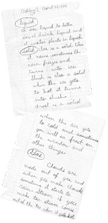 avun
powder snow avun
powder snow- sigu ice
- aniu snow on ground
- kuuk river
- qannatuq snow falling down
- qilakluk cloud
- qaniq snowflake
- iziq steam
4
Fill a clear plastic bottle or pop can with water. Replace cap.
Ask students to predict what will happen when the bottle is frozen.
Record predictions and explanations in journals using words and
pictures. Make qualitative and quantitative observation of the
bottle/cans of water. Record observations in journals. Put bottles/cans
outside (if cold enough) or in freezer. After it is frozen record
both qualitative and quantitative observations.
|
 |

Expanded Sample
Assessment Idea
|
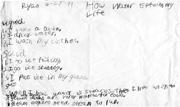 Students
develop a strategy to sink an ice cube. Students
develop a strategy to sink an ice cube.
Procedure
Students will:
- Predict if they can sink an ice cube.
- Work in teams to develop a strategy to make the ice sink.
- Demonstrate their ice-sinking apparatus; share strategies
and observations with the class.
Reflection and Revision
Why is ice so hard to sink? Discuss the properties of ice and
water (what they look like, feel like, smell like, taste like
and how they behave in relation to sinking and floating.) How
are these two forms of water alike and how are they different?
Discuss density.
Level of Performance
|
|
|
Student work is complete, correct, shows evidence
of logical reasoning and transfer and extension of knowledge related
to the physical properties of the three states of water. Explanation
of water’s change of state includes correct terminology, physical
properties of each state of water, a description of where each phase
occurs in nature, and an example of how each change in the state of
water affects the local community. The student describes a detailed
strategy to sink an ice cube or explains why it isn’t possible |
|
|
Student work shows evidence of logical reasoning and
transfer of knowledge related to the physical properties of the three
states of water, but may contain minor errors or omissions. Student
explanation of water’s change of state includes correct terminology,
physical properties of some of the states of water, some descriptions
of where water occurs in nature and at least one example of how a
change in the state of water affects the local community. The student
describes a strategy to sink an ice cube |
Stage 2


|
Student work contains omissions or errors of science
fact and reasoning. Student explanation of water’s change of
state may identify an example of where water occurs in nature, describes
an example of how water is used within the local community, uses some
appropriate terminology, and may describe some physical properties
of water in one of its three states. A strategy to sink an ice cube,
if included, may be incomplete or lack detail. |
Stage 1

|
Student explanation of the change of state of water is largely
incomplete, incorrect, and shows little evidence of understanding
the role of water in the local community.
|
 |

Standards Cross-Reference
(Alaska
Department of Education & Early Development Standards)
|
National Science
Education Standards
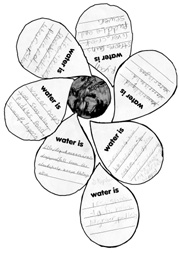 Objects
have many observable properties, including size, weight, shape,
color, temperature, and the ability to react with other substances.
These properties can be measured using tools, such as rulers,
balances, and thermometers. (Pg. 127) Objects
have many observable properties, including size, weight, shape,
color, temperature, and the ability to react with other substances.
These properties can be measured using tools, such as rulers,
balances, and thermometers. (Pg. 127)
Materials can exist in different states – solid, liquid,
and gas. Some common materials, such as water, can be changed
from one state to another by heating or cooling. (Pg. 127)
A substance has characteristic properties, such as density,
a boiling point, and solubility, all of which are independent
of the amount of the sample. A mixture of substances often can
be separated into the original substances using one or more of
the characteristic properties. (Pg. 154)
Benchmarks
Heating and cooling cause changes in the properties of materials.
Many kinds of changes occur faster under hotter conditions. (Pg.
77)
When a new material is made by combining two or more materials,
it has properties that are different from the original materials.
For that reason, a lot of different materials can be made from
a small number of basic kinds of materials. (Pg. 77)
|
|
|
Alaska Science Content
Standard Key Element
A
student who meets the content standard should understand the physical,
chemical, and nuclear changes and interactions that result in observable
changes in the properties of matter.
Cross-Reference
Additional
Content and Performance Standards: B1, D1 and D3
|





 Read
the book Go Home River by Jim Magdanz; ask the students what they
know about the states of water, how and where it exists around
the community. List.
Read
the book Go Home River by Jim Magdanz; ask the students what they
know about the states of water, how and where it exists around
the community. List. Students
conduct an interview of Elders or adults in the community or their
family. Before they go, you may want to review the relevant forms
of water in all three states, such as snow, sleet, permafrost,
fog, clouds, etc.
Students
conduct an interview of Elders or adults in the community or their
family. Before they go, you may want to review the relevant forms
of water in all three states, such as snow, sleet, permafrost,
fog, clouds, etc. avun
powder snow
avun
powder snow Students
develop a strategy to sink an ice cube.
Students
develop a strategy to sink an ice cube. Objects
have many observable properties, including size, weight, shape,
color, temperature, and the ability to react with other substances.
These properties can be measured using tools, such as rulers,
balances, and thermometers. (Pg. 127)
Objects
have many observable properties, including size, weight, shape,
color, temperature, and the ability to react with other substances.
These properties can be measured using tools, such as rulers,
balances, and thermometers. (Pg. 127)